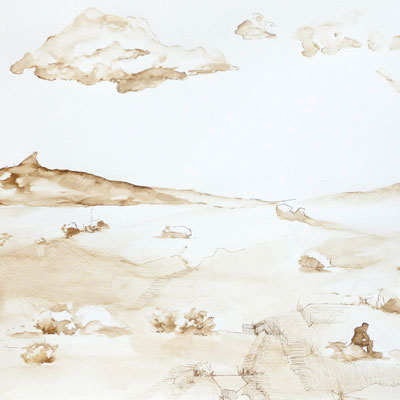


SAND Marie
(1972-)
“Everything I know about art, I learned from the horse and nature” recalls the painter Sand. Employed in Washington by the World Wildlife Fund, the famous association campaigning for the preservation of the wild world, she attended the Washington Studio School at the same time. There, she was taught to work from live models and the technique of the blind contour, which she frequently uses for what she calls the “emotion portrait”, the keystone of the work of this “environmentalist” painter.
An “emotion portrait” goes through a number of clearly defined stages. An initial meeting enables Marie Sand to find out what the client or patron wishing to commission a portrait of an animal expects of her. The next stage, based on the first meeting, is to choose the format and style of the portrait from a selection made by the artist. The third and crucial stage is an interview in which, with the model absent, the sitter reveals oneself to the artist. This exchange creates a textured relationship with the animal. Dazzle and explosiveness will be expressed in charcoal or acrylic, while the evocation of a deep bond with a horse will use oil on a large format.
Then comes the creative process, during which Marie sand reveals to the commissioner the inspirations that run through her at key moments in her work. The penultimate stage of the process is her presentation of the art piece, sometimes in a second variation, and finally its delivery.
Marie Sand uses the Italian palette of yellow, Venetian red, white and black, which may seem very limited, but with which she obtains all the colors. Working with a mirror behind her allows her to look at her work through the reflection of the mirror, to escape focal vision, and helps her to see the structure, the great masses of her drawing or painting. What’s more, this upside-down view offers the advantage of being able to see if something looks off.
Marie Sand offers drawing lessons based on live horses in surprising places like the gardens of the Villa Medici in Rome or a disused factory in Helsinki, or more familiar places like, in 2015, La Cense stud farm. “My aim is to demystify drawing,” she says. Not knowing how to draw is not an obstacle to take part.
Marie Sand loves the nomadic life and recognizes that “travelling is part of a process that leads to a better understanding of ourselves”. Her favorite countries are Namibia, Finland and Mongolia, all of which have nomadic horses in common, as well as a wealth of light and color. Paintings and drawings by this artist are on permanent display in Washington (USA) at Susan Calloway Fine Art.
She has also published a book-album entitled Deepen the Unspoken Connection, which presents her work through different themes (emotions, portraits, nature and horses).
Christophe Hercy

